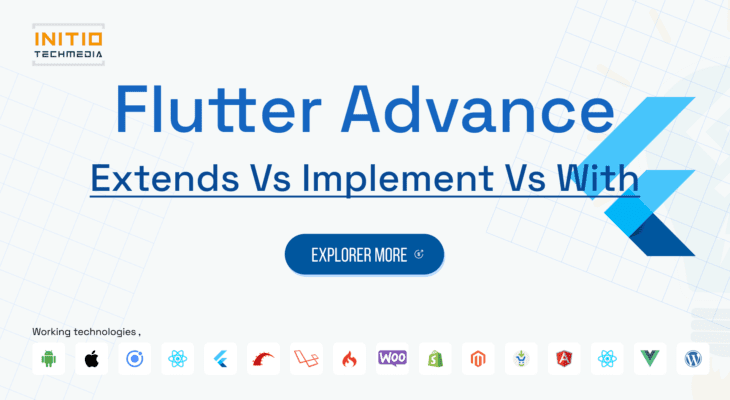Leading Mobile & web Development company which is providing Ready to publish apps & on demands application in Global Bussiness.
- 908, B Square 2, Ambli Rd, near Hotel Double tree Hilton, Vikram NagarAhmedabad-380054, Gujarat, India
- (+91) 8758432204Give us a call
- contact@initiotechmedia.com24/7 online support

Flutter Object-Oriented Programming: Understanding the Differences between ‘extends,’ ‘implements,’ and ‘with’
- payal patel
- March 23, 2023
- 0
Differences between ‘extends,’ ‘implements,’ and ‘with’
When working with object-oriented programming in Flutter, you may come across two keywords: “extends” and “implements.” Both of these keywords have specific meanings and uses, and it’s essential to understand the differences between them to make the most of your code.
In this blog post, we’ll explore the difference between “extends” and “implements” in Flutter, how they are used, and when to use them.
What is “extends” in Flutter?
“Extends” is a keyword used to indicate that a class is inheriting from another class. In Flutter, inheritance is a way to create a new class that is a variation of an existing class. The new class, known as the child class, inherits all the properties and methods of the parent class, known as the superclass, and can also add new properties and methods or override existing ones.
Here’s an example of how “extends” is used in Flutter:
class Animal {
String name;
void makeSound() {
print(“Animal sound”);}}
class Dog extends Animal {
void makeSound() {
print(“Bark”);}}
In this example, the “Dog” class extends the “Animal” class. The “Dog” class inherits the “name” property and “makeSound” method from the “Animal” class but overrides the “makeSound” method to print “Bark” instead of “Animal sound.”
What is “implements” in Flutter?
“Implements” is a keyword used to indicate that a class is implementing an interface. An interface is a set of method signatures that a class must implement. In Flutter, interfaces are used to define a contract that a class must follow.
Here’s an example of how “implements” is used in Flutter:
abstract class Animal {
void makeSound();
}
class Dog implements Animal {
void makeSound() {
print(“Bark”);
}
}
In this example, the “Dog” class implements the “Animal” interface. The “Animal” interface defines the “makeSound” method, which the “Dog” class must implement. In this case, the “Dog” class implements the “makeSound” method to print “Bark.”
When to use “extends” and “implements” in Flutter?
Use “extends” when you want to create a new class that inherits properties and methods from an existing class and can add new properties and methods or override existing ones. Use “implements” when you want to define a contract that a class must follow, such as implementing a set of method signatures.
In general, inheritance is used to create a hierarchy of classes, where each class inherits properties and methods from a parent class, while interfaces are used to define a set of method signatures that a class must implement.
What is a mixin in Flutter?
A mixin is a way to reuse a class’s code in multiple class hierarchies. A mixin is like an interface, in that it defines a set of method signatures that a class must implement, but it also provides default implementations for those methods.
Here’s an example of how a mixin can be defined in Flutter:
mixin Swimmer {
void swim() {
print(“Swimming…”);
}
}
In this example, the “Swimmer” mixin defines a “swim” method that can be used by any class that implements the mixin.
How to use “with” keyword in Flutter?
To use a mixin in a class, the “with” keyword is used, followed by the mixin’s name. Here’s an example of how the “with” keyword is used in Flutter:
class Dolphin extends Animal with Swimmer {
void makeSound() {
print(“Clicking…”);
}
}
In this example, the “Dolphin” class extends the “Animal” class and implements the “Swimmer” mixin. The “Dolphin” class inherits the “makeSound” method from the “Animal” class and implements the “swim” method from the “Swimmer” mixin.
When to use the “with” keyword in Flutter?
Use the “with” keyword when you want to reuse code across multiple class hierarchies without creating a new class hierarchy. Mixins are a powerful way to reuse code and provide default implementations for methods.
In conclusion, the “extends,” “implements,” and “with” keywords in Flutter are all essential tools for working with classes and inheritance. Understanding the differences between these keywords and when to use them is essential to write efficient and maintainable code in Flutter. By using these keywords appropriately, you can create classes that are flexible, reusable, and easy to maintain.
WhatsApp us

